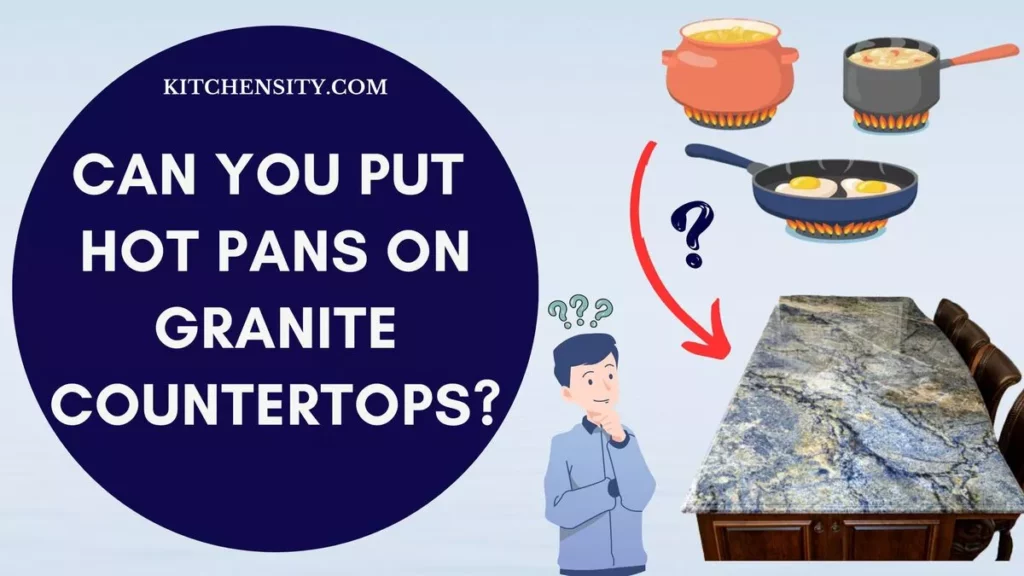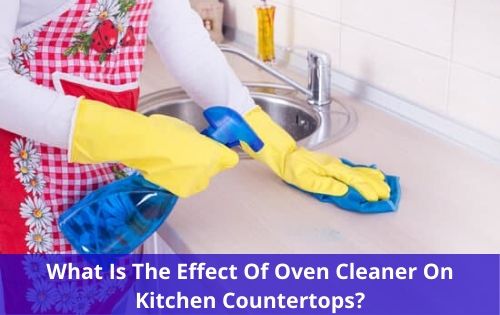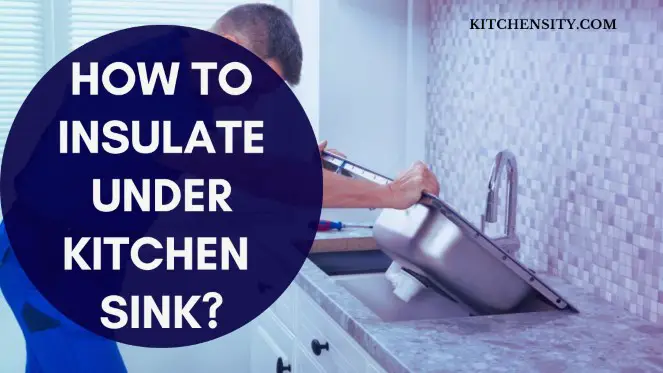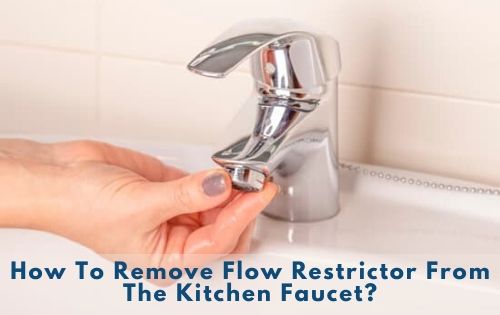Granite countertops have become a popular choice for kitchens due to their durability, aesthetic appeal, and ability to withstand daily wear and tear.
However, the question often arises: Can you put hot pans on granite countertops?
In this article, we will explore the pros and cons of placing hot pans on granite surfaces, offer some tips for maintaining the longevity of your countertops, and address common concerns.

Table of Contents
- 1 Can You Put Hot Pans On Granite Countertops?
- 2 Understanding Granite Countertops
- 3 Potential Risks Of Putting A Hot Pan On Granite
- 4 Best Practices For Using Hot Pans On Granite
- 5 What Happens If You Put A Hot Pot Or Pan On A Granite Countertop?
- 6 How Do You Protect Granite From Hot Pans?
- 7 Maintaining The Beauty Of Your Granite Countertops
- 8 The Importance Of Sealing Granite Countertops
- 9 How To Repair Granite Countertops That Have Been Damaged By Hot Pans?
- 10 Final Verdict
- 11 Frequently Asked Questions (FAQs)
- 11.1 At What Temperature Does Granite Crack?
- 11.2 Can You Place Hot Pans Directly On Granite Countertops?
- 11.3 What Is Thermal Shock, And How Does It Affect Granite?
- 11.4 How Often Should Granite Countertops Be Sealed?
- 11.5 Can Granite Withstand Extremely High Temperatures?
- 11.6 Is It Possible To Repair A Cracked Granite Countertop?
Can You Put Hot Pans On Granite Countertops?
Yes, you can place hot pans on granite countertops without causing immediate damage. Granite is naturally heat-resistant and can generally handle the heat generated from regular cooking. However, to prevent potential thermal shock, it’s recommended to use trivets or hot pads to create a protective barrier.
Also Read – Can You Put A Hot Pan On Quartz?
Understanding Granite Countertops
Granite is an igneous rock formed deep within the Earth’s crust. It’s known for its unique and natural beauty, with each slab showcasing intricate patterns and colors.
The stone is extracted from quarries, cut into slabs, and polished to create stunning countertops.
Due to its hardness and resistance to scratching, granite is a preferred choice for kitchens.
Thermal Properties Of Granite
Granite is a naturally heat-resistant material, making it suitable for use in kitchens. Its thermal properties are:
- Heat Resistance:
- Granite’s interlocking crystals dissipate heat effectively.
- Ideal for kitchen countertops to withstand hot pans and pots.
- Thermal Stability:
- The crystalline structure maintains stability during temperature fluctuations.
- Reduces the risk of cracks or fractures.
- Conduction and Radiation:
- Poor conductors of heat limit heat transfer.
- Effective heat reflection and radiation enhance resistance.
- Thermal Inertia:
- Exhibits thermal inertia, retains and slowly releases heat.
- Useful for temperature-regulated environments.
- Thermal Expansion:
- Undergoes low thermal expansion compared to other materials.
- Minimizes cracking risk when exposed to heat.
Also Read – Can I Put An Air Fryer On The Countertop?
Different Types Of Granite Countertops And Their Heat Resistance
Granite countertops come in a wide range of colors, patterns, and compositions, each with its unique heat resistance properties. Here’s a look at some common types of granite and their varying heat resistance levels:
- Dark Granites:
- Dark granites, such as Absolute Black or Galaxy Black, tend to have higher heat resistance.
- Their dense composition and dark color help them absorb and dissipate heat effectively.
- Light-Colored Granites:
- Light-colored granites like Bianco Romano or White Ice have moderate heat resistance.
- While they may not dissipate heat as quickly as darker granites, they still offer reliable protection against normal cooking temperatures.
- Exotic Granites:
- Exotic granites, with intricate patterns and unique colors, often vary in their heat resistance.
- The composition and density of these granites play a role in their ability to handle heat.
- Flecked Or Speckled Granites:
- Granites with flecks or speckles, such as Ubatuba or Santa Cecilia, generally exhibit good heat resistance.
- The speckled patterns can disperse heat, contributing to their ability to withstand high temperatures.
- Patterned Granites:
- Granites with intricate patterns, like Typhoon Bordeaux or Rainforest Green, may have varying heat resistance.
- The heat resistance can depend on the specific minerals present in the pattern.
- Consistent Grains:
- Granites with consistent grain patterns, such as Baltic Brown or Tan Brown, usually have reliable heat resistance.
- The uniform composition helps in even heat distribution.
- Movement And Veining:
- Granites with strong movement and veining, like Verde Butterfly or Blue Bahia, can vary in heat resistance.
- The presence of different minerals and structures can impact their ability to handle heat.
- Porosity And Heat Resistance:
- The level of porosity in granite can influence its heat resistance.
- Generally, less porous granites are more heat-resistant, as they are less likely to absorb and retain heat.
It’s important to note that even within a specific type of granite, variations can exist due to factors such as quarry location and mineral composition.
While many granites can handle normal cooking temperatures, it’s advisable to follow protective measures like using trivets or hot pads to preserve the integrity and beauty of your countertops, regardless of the specific granite type you choose.
Also Read – What Is The Effect Of Oven Cleaner On Kitchen Countertops?
Here’s a table showcasing different types of granite countertops and their general heat resistance levels:
| Granite Type | Heat Resistance | Characteristics |
| Dark Granites | High | Dense, dark color for effective heat absorption |
| Light-Colored Granites | Moderate | Reliable protection against normal cooking temperatures |
| Exotic Granites | Varies | Heat resistance depends on composition and density |
| Flecked/Speckled Granites | Good | Speckled patterns disperse heat effectively |
| Patterned Granites | Varies | Heat resistance can vary with specific mineral content |
| Consistent Grains | Reliable | Uniform composition aids in even heat distribution |
| Movement and Veining | Varies | Heat resistance influenced by mineral presence |
| Porosity and Heat Resistance | Varies | Less porous granites are generally more heat-resistant |
Potential Risks Of Putting A Hot Pan On Granite
While granite is durable, extreme and sudden temperature changes can pose a risk. Placing a scalding hot pan on a cold granite surface could potentially lead to thermal shock, causing cracks or fractures.
There are potential risks associated with this practice that should be considered:
- Thermal Shock:
- Rapid temperature changes can cause thermal shock.
- Hot pan contact with a cold granite surface may result in cracks or fractures.
- Sealant Sensitivity:
- Some granite sealants are sensitive to high temperatures.
- Heat exposure could compromise the effectiveness of the sealant, leading to potential staining or moisture penetration.
- Uneven Heat Distribution:
- Placing a hot pan directly on granite may lead to uneven heat distribution.
- This could affect the appearance and structural integrity of the granite surface over time.
- Risk Of Discoloration:
- Extremely hot pans could potentially cause localized discoloration on the granite surface.
- This may alter the aesthetics of the countertop and be difficult to reverse.
- Weakened Sealants:
- Repeated exposure to high heat may gradually weaken sealants.
- This could result in diminished protection against moisture, stains, and bacterial growth.
- Microcracks And Fractures:
- While granite is heat-resistant, it’s not entirely immune to damage.
- Extreme heat, especially when combined with other factors, could contribute to the development of microcracks or fractures.
To mitigate these risks, it’s advisable to use protective measures such as trivets or hot pads when placing hot pans on granite countertops.
These precautions can help preserve the longevity and appearance of your granite surfaces while minimizing the potential for damage.
Also Read – Why Eggs Turn Green In Aluminum Pans?
Best Practices For Using Hot Pans On Granite
When it comes to placing hot pans on granite countertops, a few simple practices can help ensure the longevity and pristine appearance of your surfaces. Here are some recommended best practices:
- Use Trivets Or Hot Pads:
- Place a trivet or hot pad between the hot pan and the granite surface.
- This creates a protective barrier that prevents direct contact and potential heat transfer.
- Preheat Gradually:
- If you intend to place a hot pan on the countertop, allow it to cool slightly before doing so.
- Alternatively, preheat the countertop gradually by using a warm cloth or other indirect heat source.
- Avoid Sudden Temperature Changes:
- Rapid temperature changes can lead to thermal shock and potential cracking.
- Avoid placing extremely hot pans directly on a cold granite surface.
- Monitor Sealant Sensitivity:
- Be aware of the type of sealant used on your granite countertops.
- Some sealants may be sensitive to high temperatures, potentially affecting their efficacy over time.
- Rotate Placement:
- To prevent consistent exposure to heat in one area, consider rotating the placement of hot pans on different parts of the countertop.
- Use Cookware With Handles:
- Opt for cookware with handles to lift hot pans, reducing the likelihood of direct contact with the countertop.
- Protect Edges And Corners:
- Focus on protecting the edges and corners of your granite countertop, as these areas are more susceptible to damage from heat.
- Regular Maintenance:
- Continue regular maintenance practices such as cleaning and sealing to ensure the longevity of your granite countertop.
By adopting these best practices, you can confidently use hot pans on your granite countertops without compromising their appearance or structural integrity.
These measures not only safeguard against potential damage but also contribute to the overall beauty and functionality of your kitchen space.
Also Read – How To Keep Food From Sticking To Copper Pans?
What Happens If You Put A Hot Pot Or Pan On A Granite Countertop?
When you place a hot pot or pan directly on a granite countertop, several things can happen that may affect the surface:
- Heat Absorption:
- Granite can absorb heat from hot cookware due to its natural composition.
- Direct contact with hot pots can lead to heat transfer between the cookware and the granite.
- Heat Resistance:
- Granite is generally heat-resistant and can tolerate moderate heat from regular cooking.
- It’s designed to withstand the temperatures typically generated during cooking activities.
- Thermal Shock Risk:
- The primary concern is the potential for thermal shock caused by rapid temperature changes.
- Placing an extremely hot pot onto a cold granite surface could trigger the stone to expand and contract suddenly, leading to cracks or fractures.
- Aesthetic Impact:
- There’s a chance of localized discoloration on the granite surface when very hot pots are placed directly on it.
- This could alter the appearance of the countertop, and reversing such discoloration may be challenging.
- Sealant Consideration:
- Some sealants used on granite countertops might be sensitive to high temperatures.
- Exposure to heat might compromise the effectiveness of the sealant, potentially allowing stains or moisture to penetrate.
- Long-Term Damage:
- Over time, consistent exposure to extreme heat could weaken the sealant and compromise the granite’s surface.
- This might result in the development of microcracks or fractures, impacting the overall durability.
To prevent potential issues, it’s advisable to use protective measures such as trivets or hot pads when placing hot pots or pans on granite countertops.
These precautions help minimize direct heat transfer, reduce the risk of thermal shock, and preserve the appearance and integrity of your granite surface.
Also Read – Shallow Vs Deep Baking Pans
How Do You Protect Granite From Hot Pans?
Granite is a beautiful and durable countertop material, but it can be damaged by hot pans. Here are a few tips on how to protect granite from hot pans:
- Use a trivet or hot pad to protect the granite when placing hot pans on it.
- Place a silicone baking mat or a piece of parchment paper under hot pans when cooking.
- If you must place a hot pan directly on the granite, do so for as short a time as possible.
- Avoid using acidic foods on granite, as they can etch the surface.
- Seal the granite regularly with a sealant designed for granite countertops.
Some Additional Tips
- If you do accidentally damage your granite countertop with a hot pan, don’t panic. Most minor scratches and burns can be repaired with a granite polishing compound.
- If you have a dark-colored granite countertop, you may want to avoid using hot pads or trivets that are light in color. This is because the heat from the pan can cause the light-colored trivet or hot pad to melt and leave a mark on the granite.
- If you have a granite countertop with a polished finish, you may want to avoid using silicone mats. Silicone mats can sometimes leave a residue on polished granite countertops.
- If you have a granite countertop with a honed finish, you can use silicone mats without any problems. Honed granite countertops have a matte finish that is less susceptible to scratches and marks.
- If you have a gas stove, consider installing a heat diffuser under the burners. This will help to distribute the heat more evenly and prevent hot spots from forming on the granite.
- If you have a glass cooktop, make sure to use a coaster or trivet under hot pans to prevent them from scratching the surface.
- Be careful when using cast iron pans on granite. Cast iron pans can be very hot and can easily damage the granite if they are not placed on a trivet or hot pad.
- If the damage is more severe, you may need to hire a professional granite restoration company to repair it.
- With proper care and maintenance, your granite countertop can last for many years to come.
Also Read – Why Kitchen Cabinets Are So Expensive?
Maintaining The Beauty Of Your Granite Countertops
Granite countertops are not only durable but also showcase exquisite natural beauty. To ensure that your countertops continue to radiate elegance and withstand the test of time, it’s essential to follow proper care and maintenance practices.
Here’s how you can maintain the beauty of your granite countertops:
- Regular Sealing:
- Granite is porous and can absorb liquids, leading to stains and damage.
- Apply a high-quality granite sealer to create a protective barrier against moisture and stains.
- Consult with professionals to determine the appropriate sealing frequency based on usage.
- Gentle Cleaning:
- Use a mild, pH-balanced granite cleaner or a mixture of water and mild dish soap.
- Avoid harsh chemicals or abrasive cleaners that could dull the surface or strip away the protective sealant.
- Prompt Spill Cleanup:
- Wipe up spills promptly to prevent liquids from penetrating the surface and causing staining.
- Be especially cautious with acidic substances like citrus juices and vinegar.
- Avoid Abrasive Scrubbing:
- Use soft cloths or sponges for cleaning to avoid scratching the granite surface.
- Avoid abrasive scrubbing pads that could compromise the stone’s shine.
- Preventive Measures:
- Use cutting boards to prevent knife marks on the granite surface.
- Place coasters or mats under glasses and dishes to prevent direct contact.
- Regular Dusting:
- Dust the surface regularly to prevent the buildup of dirt and debris.
- Use a soft microfiber cloth or a gentle duster for this purpose.
- Avoid Excessive Weight:
- While granite is sturdy, excessive weight or pressure on unsupported areas can lead to cracks or fractures.
- Use proper support for heavy objects and avoid sitting or standing on the countertop.
- Use Trivets And Hot Pads:
- Employ trivets or hot pads to protect the surface when placing hot cookware.
- This prevents potential thermal shock and damage to the sealant.
- Professional Polishing:
- Periodically consider professional polishing to restore the shine and luster of your granite countertops.
- Regular Inspection:
- Regularly inspect the countertop for signs of wear, damage, or discoloration.
- Address any issues promptly to prevent them from worsening.
Also Read – How To Fix A Stiff Kitchen Faucet Handle?
The Importance Of Sealing Granite Countertops
Granite is a natural stone that is known for its beauty and durability. However, granite is also porous, which means that it can absorb liquids and stains. Sealing granite countertops helps to protect them from stains and damage.
Here are some of the benefits of sealing granite countertops:
- Protection From Stains: Sealing granite countertops helps to create a barrier that prevents liquids and stains from penetrating the surface. This can help to keep your countertops looking new for years to come.
- Protection From Etching: Etching is a type of damage that can be caused by acids. Sealing granite countertops helps to protect them from etching, which can be caused by acidic foods and cleaners.
- Easy To Clean: Sealed granite countertops are easier to clean than unsealed countertops. This is because the sealant helps to prevent liquids and stains from penetrating the surface.
- Increased Durability: Sealing granite countertops helps to increase their durability. This is because the sealant helps to protect the surface from scratches and abrasions.
How Often Should You Seal Granite Countertops?
The frequency with which you need to seal your granite countertops will depend on a few factors, including the type of granite, the amount of use your countertops get, and the environment in which they are located.
In general, you should seal your granite countertops every 1-2 years. However, if you live in an area with a lot of humidity, you may need to seal them more frequently.
Here are some tips for sealing granite countertops:
- Choose The Right Sealant: There are many different types of sealants available for granite countertops. It is important to choose a sealant that is specifically designed for granite.
- Prepare The Surface: Before you seal your granite countertops, it is important to clean them thoroughly and remove any dirt, grease, or debris.
- Apply The Sealant: Apply the sealant evenly to the surface of the countertops using a brush or roller. Be sure to follow the manufacturer’s instructions carefully.
- Let The Sealant Dry: Allow the sealant to dry completely before using your countertops. This may take several hours or even overnight.
By following these tips, you can help to ensure that your granite countertops stay looking beautiful and protected for years to come.
Also Read – Best Insulation Under The Kitchen Sink
How To Repair Granite Countertops That Have Been Damaged By Hot Pans?
Granite is a durable stone, but it can be damaged by hot pans. If you accidentally place a hot pan on your granite countertop, it can cause the surface to discolor or crack.
Additionally, the heat from a hot pan can cause the sealant on the granite to break down, which can make the surface more porous and susceptible to staining.
Here’s how to repair granite countertops that have been damaged by hot pans:
- Assessment: Begin by assessing the extent of the damage. Determine if the damage is superficial or if cracks or fractures have developed.
- Consult A Professional:
- For significant damage, it’s advisable to consult a professional stone restoration expert.
- They can provide a proper assessment and recommend the best course of action for repair.
- Minor Surface Burns:
- If the damage is minor, such as surface burns or discoloration, you might be able to address it yourself.
- Start by cleaning the damaged area with a mild cleaner and water, then gently pat it dry.
- Buffing And Polishing:
- For surface burns, try buffing the affected area with a fine-grit diamond polishing pad.
- This can help remove the damaged layer and restore the shine. Follow with polishing to blend the repaired area with the rest of the surface.
- Epoxy Resin Repair:
- For minor cracks or chips, consider using epoxy resin specifically formulated for stone repair.
- Clean the damaged area thoroughly and apply the epoxy according to the manufacturer’s instructions.
- Once cured, sand and polish the repaired area to match the surrounding surface.
- Professional Restoration:
- For more significant cracks or fractures, professional help may be necessary.
- Skilled technicians can use advanced techniques like resin filling, resealing, and color matching to restore the countertop’s appearance.
- Sealing And Maintenance:
- After repairs, ensure that the repaired area is properly sealed to prevent further damage.
- Follow a regular sealing and maintenance schedule to protect your countertop from future harm.
- Prevention Moving Forward:
- To prevent further damage, always use trivets or hot pads when placing hot pans on the countertop.
- Adopt protective measures to minimize the risk of future accidents.
It’s important to note that DIY repairs may not yield the same results as professional restoration, especially for extensive damage. When in doubt, consulting a professional is the best approach to ensure your granite countertop is properly repaired and restored to its original condition.
Also Read – How to Insulate Under Kitchen Sink?
Final Verdict
While granite countertops are known for their heat resistance, it’s important to exercise caution when placing hot pans on them. As they can generally withstand normal cooking temperatures, the risk of thermal shock and potential damage exists.
If you put a hot pan on granite for an extended period, it can cause the surface to discolor or crack. Additionally, the heat from a hot pan can cause the sealant on the granite to break down, which can make the surface more porous and susceptible to staining.
Utilizing protective measures like trivets or hot pads not only safeguards the granite’s appearance and longevity but also ensures a harmonious balance between functionality and aesthetics in your kitchen.
Also Read – How To Unclog A Sink Clogged With Coffee Grounds?
Frequently Asked Questions (FAQs)
-
At What Temperature Does Granite Crack?
Granite can potentially crack due to thermal shock at temperatures around 575 to 625 degrees Celsius (1067 to 1157 degrees Fahrenheit). However, minor cracks could occur at lower temperatures if the granite is exposed to sudden and extreme temperature changes.
-
Can You Place Hot Pans Directly On Granite Countertops?
Yes, but it’s recommended to use trivets or hot pads to protect the surface.
-
What Is Thermal Shock, And How Does It Affect Granite?
Thermal shock refers to rapid temperature changes that can cause cracks in granite and other materials.
-
How Often Should Granite Countertops Be Sealed?
Granite countertops should be resealed every 1 to 3 years, depending on usage.
-
Can Granite Withstand Extremely High Temperatures?
While granite is heat-resistant, it’s advisable to use precautions like trivets for extremely hot items.
-
Is It Possible To Repair A Cracked Granite Countertop?
Small cracks can often be repaired by professionals using epoxy resin.
Katrina Smith is a seasoned expert with over 25 years of experience in all things related to cooking and the kitchen. As an avid cook and kitchen enthusiast, she is passionate about sharing her knowledge and expertise on cookware, kitchen appliances, kitchen tips, and kitchen staples.
Through her articles and reviews, Katrina aims to inspire and help others improve their cooking skills, experiment with different ingredients, and invest in quality cookware and appliances.

![How To Unclog A Sink Clogged With Coffee Grounds? [3 Effective Ways] 3 How-to-Unclog-a-Sink-Clogged-With-Coffee-Grounds](https://www.kitchensity.com/wp-content/uploads/2020/06/How-to-Unclog-a-Sink-Clogged-With-Coffee-Grounds.jpg)


![Best Insulation Under The Kitchen Sink [3 Top Insulations] 6 Best Insulation Under The Kitchen Sink](https://www.kitchensity.com/wp-content/uploads/2023/04/Best-Insulation-Under-The-Kitchen-Sink.jpg)

